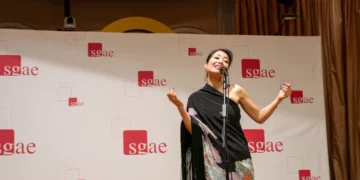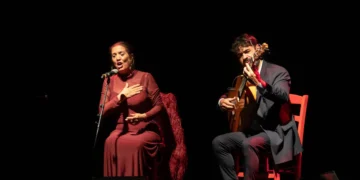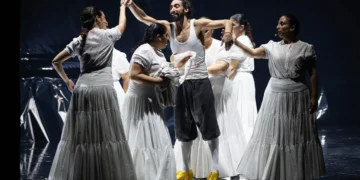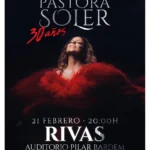|
Zatania
| Daily coverage BIENAL DE FLAMENCO sponsored by: |
Cante: Curro de Malena, José Valencia, Manuel de Paula.
Sevillanas: Juana Vargas, María Jesús García,
María Peña. Guitar: Antonio Malena, Antonio Moya,
Manuel de Palma. Palmas: Francisco de Paula Carrasco, Luis Carrasco.
Master of ceremonies, script and director: José Luis Ortiz
Nuevo.
It’s unfortunate that nowadays flamenco derivatives
can be presented in a spectacular way thanks to the generous financing
they enjoy, while the most traditional artists often are forced
to offer a sadly humble, limited and outmoded look to the general
public since they have to make due with limited resources. It’s
possible as well that those same traditional artists, with an attitude
that is as flamenco as their performances, fail to tend to the details
of staging, lighting, amplification and other concerns formerly
not related to flamenco. This was the case with the people from
Utrera three weeks ago, and the same flaws were repeated on September
30th by the group from Lebrija.
The absence due to tragic personal circumstances of Inés
Bacán, an important cog in the wheel of Lebrija cante, did
not augur well for a successful evening. The voice of director José
Luis Ortiz Nuevo began by informing of the change of program which
he dedicated to Inés. The three singers started with tonás
followed by Curro Malena, the most experienced and polished of the
group, por siguiriyas, young José Valencia por tientos and
Manuel de Paula por soleá, each with his own guitarist. Discreet
but dignified.
Ortiz Nuevo then explains that not everything is bleak and tragic
in Lebrija and the traditional sevillanas corraleras, a Lebrija
specialty, are needed to cheer things up. Three charming older ladies
appear on stage to sing a capella with their rancid voices to their
own percussive accompaniment, the one about “the cat on your
roof, imagine that, lalala…” who “scratches his
belly with a roof tile”. Then more sevillanas with guitar
and palmas, and more…and more and more…and it just doesn’t
wash, and the members of the audience start slipping out for a smoke,
inventing their own intermission.
After the real intermission, we return prepared to forgive and
forget, but aside from a guitar solo by the three guitarists “Remembering
Pedro Bacán”, and some wonderful alegrías (cantiñas)
of Pinini dedicated to Inés and sung by José Valencia,
the flow once again deteriorates. The unmistakable compas and aroma
of Lebrija bulerías with songs of Chozas and Antonia del
Pozo is a delight, but all too soon we’re in the middle of
a baptism-style fiesta, charming but far too long, the kind of fiesta
all flamenco fans are familiar with and whose enjoyment is irrevocably
linked to folding wooden chairs, naked lightbulbs hanging from the
ceiling, plastic cups and unruly children. From a cushy theater
seat in the hushed darkness of the Lope de Vega, unfortunately,
it just doesn’t work.
|
Inés Bacán 'Soledad sonora' |
|
|
Descubre más desde Revista DeFlamenco.com
Suscríbete y recibe las últimas entradas en tu correo electrónico.


























